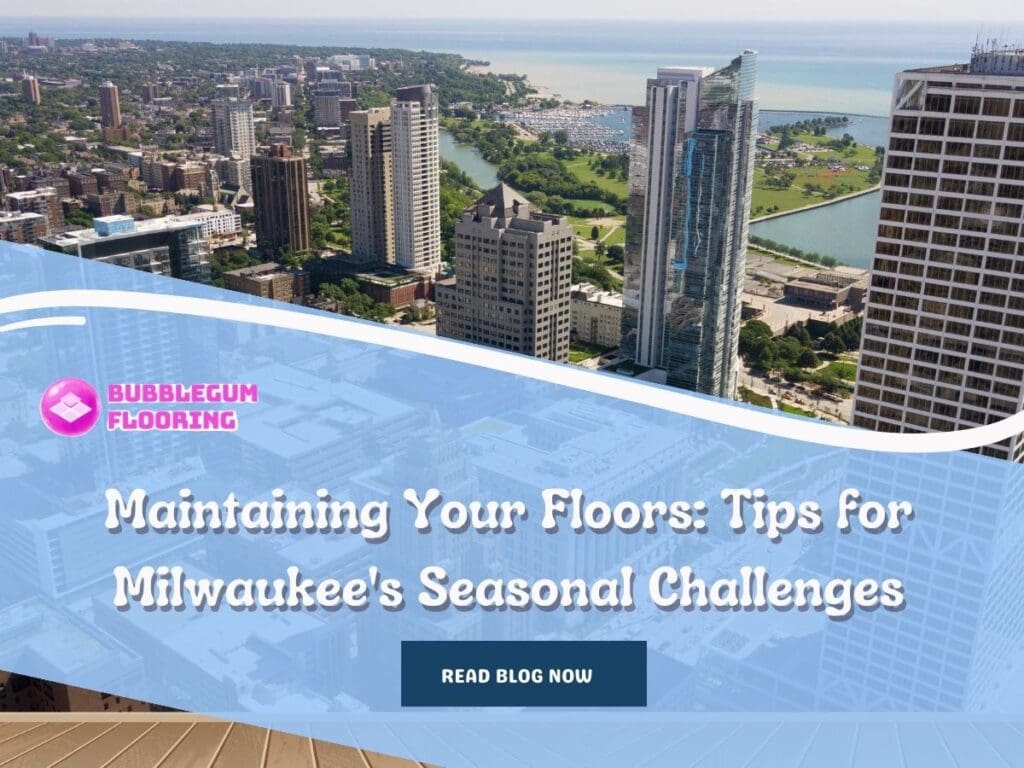Given the variety of conditions Milwaukee experiences—from chilly winters with lots of snow to steamy summers—it matters to modify your floor cleaning routine accordingly. Whether your floors are hardwood, carpet, tile, or vinyl, maintaining their longevity and aesthetic appeal requires an awareness of the unique difficulties presented by the local environment.
Each season brings with it new maintenance tasks for your residential or commercial property as the clocks move forward. Like home upkeep, seasonal professional checklist items usually include cleaning and landscaping to get rid of the feeling of being stuck indoors after a long, chilly winter. Below are some tips in maintaining your floors in Milwaukee.
How Weather Can Affect Wood Flooring
Wood can expand in the winter and contract under dry conditions. Wood floors like bamboo and hardwood are a staple in many homes, and knowing how to maintain hardwood is important for ensuring the flooring lasts for decades.
One crucial component is understanding how wood floors change from season to season. Temperatures can impact wood, but changes in humidity impact this flooring material more.
Thermal Expansion
This all comes down to the cells that form structures for sap to travel through. Once chopped for lumber, the sap dries up, leaving tubular structures that shrink or expand based on the presence of moisture.
Once the sap dries up, the tubular structures of the wood will shrink if the air is dry. But if there’s rain, snow, or humidity, those structures will absorb the moisture, swell, and expand the wood.
Wood might experience some thermal expansion as temperatures rise above an ideal 75°F, but the impact is minimal in comparison to how wood changes based on moisture content.
Humidity
Humidity is the main factor that changes how floors expand or shrink. The ideal humidity level for wood is 35% to 55%.
If the temperature is high, which might typically cause a little bit of expansion, but the moisture content is low, which causes shrinkage, the net result is shrinkage rather than expansion.
Seasonal Maintenance Tips
The secret to prolonging the life of your floor is to maintain uniform heat and humidity. Your flooring will expand when exposed to moisture as it soaks it up, but it will contract when exposed to dry air. Keep in mind that bamboo and wood are natural materials, so if the humidity levels in your house aren’t managed, that will happen.
In addition, a lot of places would only require a routine examination to ensure they remain in good condition following any weather-related damage. Lastly, getting warm-weather-based mechanicals back in working order is a priority after they were neglected during the cold season.
1. Wood Floors
Appreciated for its timeless appeal, wood flooring like hardwood and bamboo is a popular choice in Milwaukee. Tough stains can be removed using a gentle mop with a mixture of water and a wood-friendly cleaner.
Use microfiber mops for regular cleaning to minimize the risk of scratching your hardwood floors. Brands like O-Cedar and Swiffer offer effective, non-abrasive options that can easily trap dust and debris.
You can also consider a professional polish to restore the luster and a high-quality winter sealant designed specifically for hardwood floors with products having moisture-repelling properties. Brands like Bona and Minwax offer excellent options known for their durability.
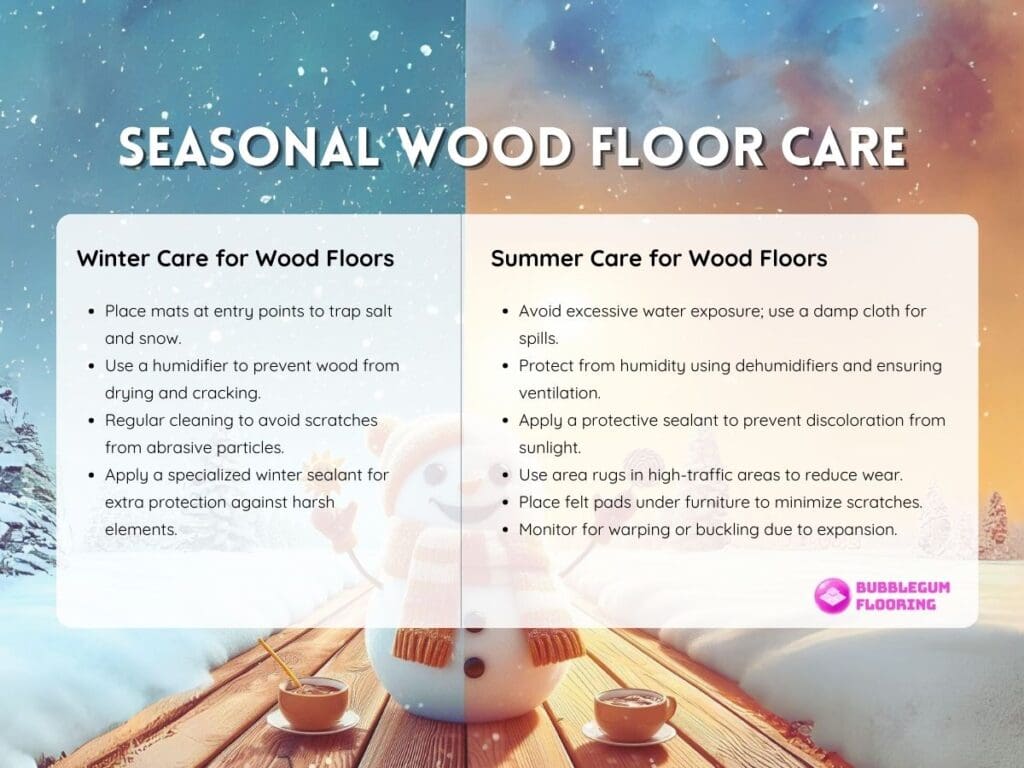
Summer
With summer’s warmth comes increased humidity, which can cause wood to expand, calling for caution against excessive water exposure during cleaning. Instead, use a damp cloth to wipe away spills, as prolonged exposure to moisture can lead to warping.
With the heat comes the susceptibility to wear and tear, which can be reduced by adding an area rug in high-traffic areas like entryways and placing felt pads under furniture legs to minimize scratches helps as well. You should also consider applying a fresh coat of protective sealant to shield against the summer sun to avoid discoloring and fading.
Maintain a controlled indoor environment by using dehumidifiers and ensuring proper ventilation. As the wood expands, it may show indications of warping or buckling. Monitor it frequently and take quick action to stop any problems before they get worse.
Winter
Protect your wood floors from the harshness of winter by placing mats at all entry points to trap salt and snow. Use a humidifier to combat the drying effects of indoor heating, preventing your wood from cracking.
Regularly cleaning and sweeping helps prevent abrasive particles from scratching the surface, and applying a specialized winter sealant before the season begins adds an extra layer of protection against the harsh elements.
2. Carpet
Carpet flooring is favored for its warmth and comfort, particularly during the cold winters in Milwaukee, though the snowy conditions pose a risk of moisture seeping into the carpet fibers. To counter this, it’s essential to implement a regular cleaning routine and invest in moisture-resistant carpets with rugs in high-traffic zones to minimize wear and tear.
Brands like Stainmaster and Shaw Floors offer a range of durable and water-resistant carpet options. Apply a carpet protector like Scotchgard and Guardsman to create a barrier against stains and spills, which offers reliable carpet protection products that can be easily applied for an extra layer of defense.
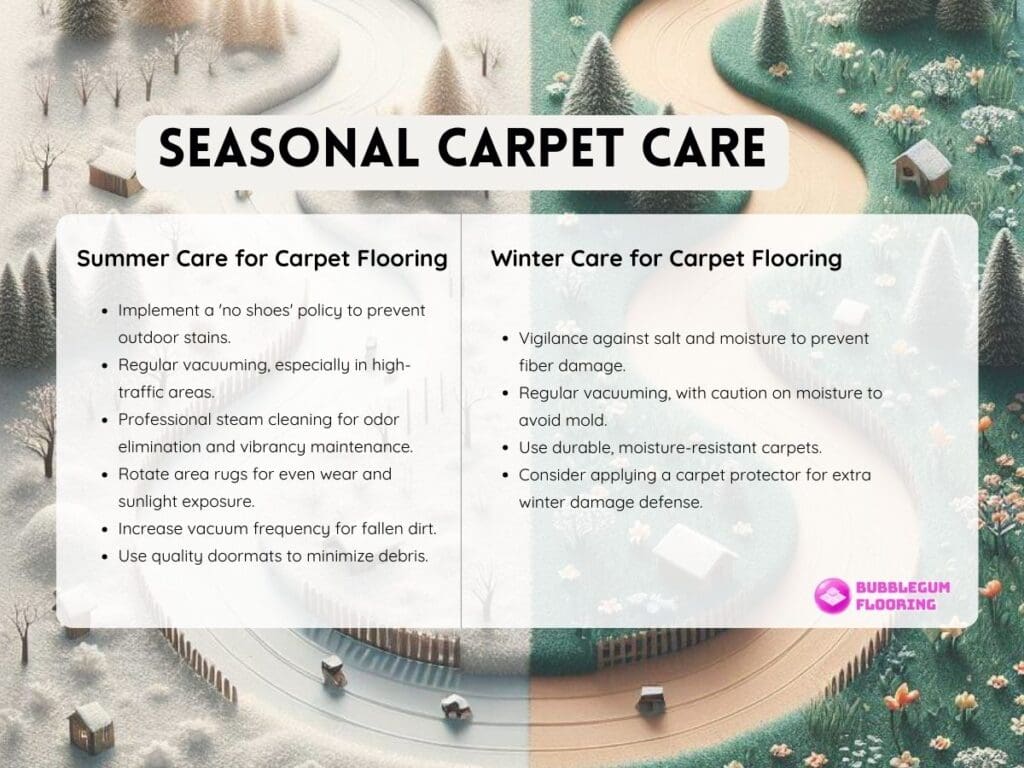
Summer
As summer brings outdoor activities indoors, protect your carpet from stains by establishing a ‘no shoes’ policy. Regular vacuuming is crucial, especially in high-traffic areas. Consider steam cleaning for a thorough refresh, eliminating any summer-induced odors and keeping your carpet vibrant.
Cleaning for carpets involves more than just vacuuming since you need to have a professional deep cleaning to remove built-up dirt and allergens. Rotate your area rugs to ensure even wear and exposure to sunlight, which is ideal for treating any lingering winter stains and refreshing the overall appearance.
Increase vacuum frequency to combat the influx of fallen dirt and invest in a quality doormat to minimize debris tracked inside.
Winter
Winter weather poses a unique set of challenges for carpets due to salt and moisture are enemies, so be vigilant about preventing them from settling into the fibers. Regular vacuuming remains essential, but be cautious with moisture during cleaning to prevent mold and mildew since wet conditions are prevalent.
Snow and slush can pose a challenge for carpets, so use durable, moisture-resistant carpets, or consider applying a carpet protector for an additional barrier against winter-related damage.
3. Tile
Tile flooring, common in areas prone to water exposure, such as kitchens and bathrooms, is a resilient option, but Milwaukee’s temperature fluctuations, especially during winter and summer, can affect the integrity of the tiles. Proper sealing is necessary to stop moisture infiltration, which can lead to more damage, especially in grout lines.
Use a mild solution of water and vinegar to clean grout lines, eliminating any discoloration or mildew. A damp mop with a pH-neutral cleaner will suffice. Check for any loose tiles and reattach or replace them as needed.
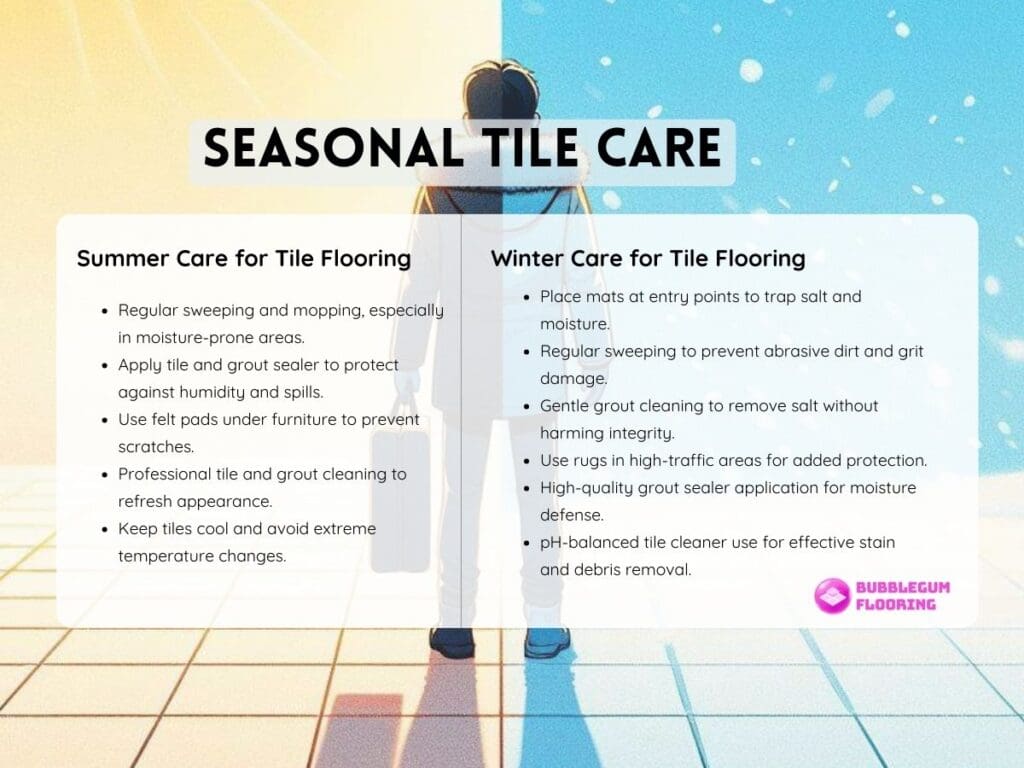
Summer
Summer calls for a balance between maintaining tile floors and enjoying the outdoor activities it brings. Regular sweeping and mopping are crucial, especially in kitchens and bathrooms. Consider applying a tile and grout sealer to protect against summer humidity and spills.
As fall approaches, focus on preventing scratches and maintaining the shine of your tile floors. Use felt pads under furniture legs, and be cautious when moving heavy items. A professional tile and grout cleaning can refresh the overall appearance, preparing your floors for holiday gatherings.
Winter
Winter’s cold and wet conditions demand extra care for tile floors. Use mats at entry points to trap salt and moisture. Regular sweeping will prevent abrasive dirt and grit from scratching the tiles. A gentle cleaning solution for grout will remove salt without compromising its integrity. Consider using rugs in high-traffic areas for added protection.
In the summer, it’s important to keep tiles cool to the touch and avoid exposing them to extreme temperature changes, which can cause expansion and contraction.
Use a high-quality grout sealer to protect the grout lines from moisture, especially during temperature fluctuations. Custom Building Products and Aqua Mix offer effective grout sealers known for their durability.
Choose a tile floor cleaner suitable for Milwaukee’s climate. pH-balanced cleaning products from companies like Zep and Bona successfully remove stains and debris without sacrificing the integrity of the tiles.
4. Vinyl
Vinyl flooring, known for its versatility and water resistance, is a practical choice for Milwaukee homeowners. However, it can be vulnerable to weather-related damage if not handled.
Place area rugs or mats in high-traffic areas to protect vinyl flooring from excessive wear and tear. Opt for brands like Gorilla Grip and Maples Rugs that offer durable and slip-resistant options.
Spring cleaning for vinyl floors involves a gentle approach, which can be done using a damp mop with a mild detergent to remove accumulated dirt and grime. Inspect for any loose edges or seams, address them promptly, and consider applying a vinyl floor polish for added protection and a renewed shine.
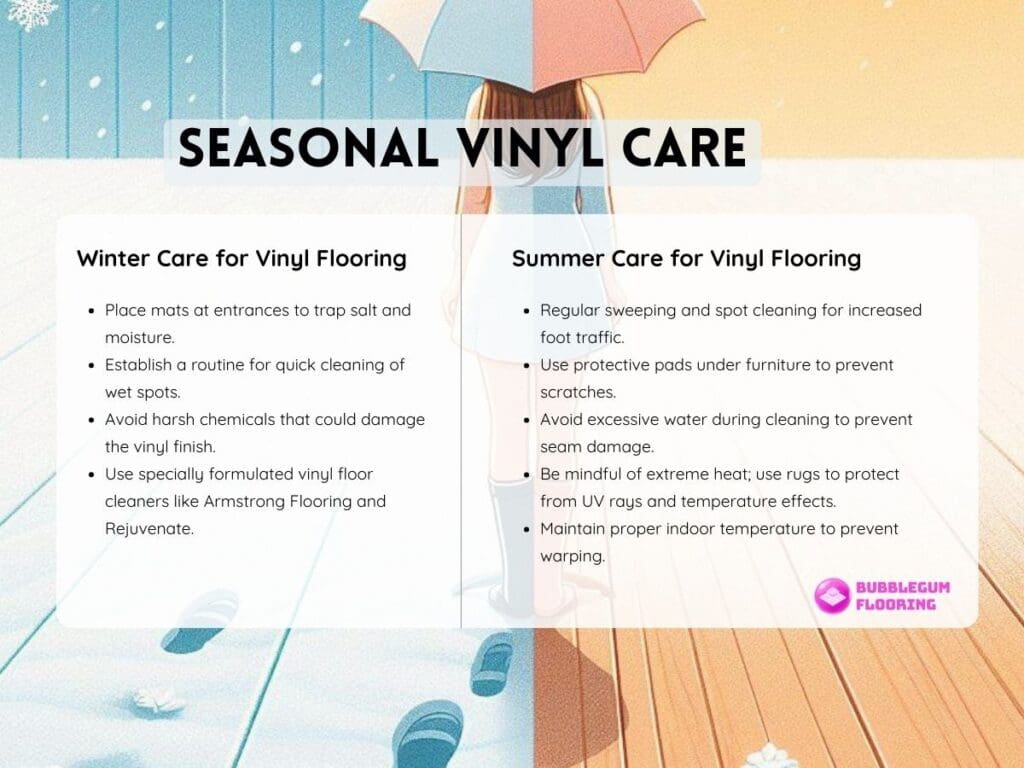
Summer
Summer brings increased foot traffic, so regular sweeping and spot cleaning are essential, along with caution with furniture placement and using protective pads to prevent scratches. Avoid excessive water during cleaning to prevent moisture from seeping into seams as it lifts off the tiles while evaporating during the high heat.
Vinyl floors can be sensitive to extreme heat, which can cause heat-related issues such as warping. To further prevent this, use rugs or mats in areas exposed to direct sunlight to minimize the impact of UV rays on the flooring’s color and integrity and ensure proper temperature control.
Winter
Winter poses a challenge for vinyl floors, with salt and moisture being common adversaries, meaning that mats placed at all entrances and an established routine for quickly cleaning up wet spots help maintain them.
Avoid using harsh chemicals, as they can damage the vinyl’s finish, but use a vinyl floor cleaner designed to maintain the integrity and appearance of vinyl flooring. Armstrong Flooring and Rejuvenate offers cleaning solutions specifically formulated for vinyl floors.
How to Know When It’s Time to Replace Your Flooring
It takes a year-round dedication to keep your flooring beautiful and long-lasting, and every season has its own set of difficulties. Whether your flooring is sophisticated hardwood, plush carpet, durable linoleum, contemporary vinyl, or traditional tiles, knowing how to care for your floors throughout the year is important.
Like your home’s foundation, your floors contribute to its appearance and usability. But with time, wear and tear become unavoidable, prompting replacement, particularly in light of changing weather conditions.It’s important to know when to replace your old flooring to keep your living area safe and attractive. Find out when to replace your flooring and what warning indicators to look out for to prevent allergens, water damage, and irreversible structural problems, among many other problems.

